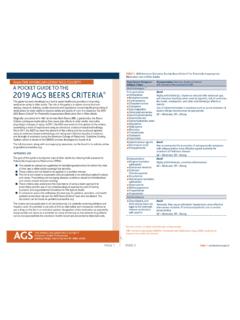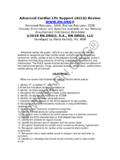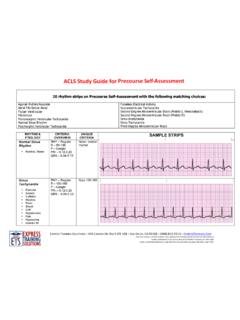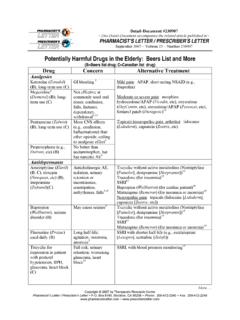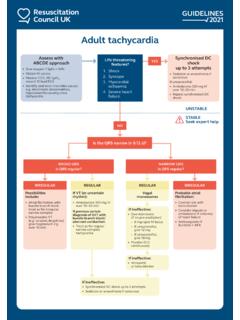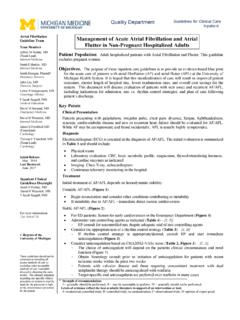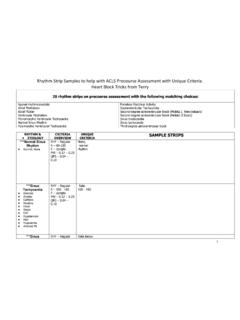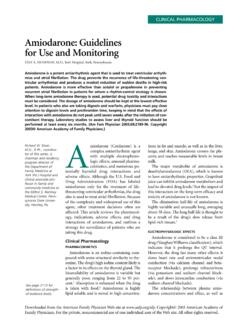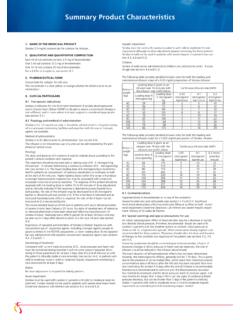Transcription of Left Ventricular Assist Device - AnMed Health
1 Left Ventricular Assist Device PHI 2016 Objectives Discuss conditions to qualify for LVAD Therapy Discuss LVAD placement and other treatment modalities Describe the Thoratec Heartmate 2 and Heartmate 3 systems Discuss assessment changes of the LVAD patient Review emergency care of the LVAD patient slide 3 Stage C or D Heart Failure slide 4 Aortic Valve Competency Sometimes valve is oversewn to allow adequate Device function RV Function- if RV dysfunction is present must be transplant candidate No PPHTN unless candidate for heart-lung transplant Hepatic Dysfunction- cirrhosis and portal HTN Renal Dysfunction- Irreversible disease vs.
2 Disease due to poor perfusion Long term dialysis and creatinine > mg/dl Cancer Psych/Social Concerns LVAD Exclusion Criteria slide 5 Hypotension Laboratory Renal insufficiency Hepatic dysfunction Hyponatremia Pulmonary Hypertension RV Dysfunction Unresponsiveness to CRT (Cardiac Resynchronization Therapy) Inotropes Symptoms Recurrent admissions Refractory At rest Medications Intolerance or lower doses ACE-I/ARBs Beta blockers Increasing diuretic doses Unable to carry out ADLs Poor nutritional status LVAD Referral slide 9 INTERMACS Classification slide 10 Referral Phase Referred to AHFC by primary cardiologist Evaluation Phase (2-4 weeks) Testing Consults with each team member Selection Committee meets weekly Surgery Phase (~4-6 weeks)
3 Admit to CCU the day before surgery Outpatient Phase Weekly clinic visits in AHFC (may be less frequent the further from surgery) Warfarin management LVAD Implantation Process slide 11 LVAD Devices Worldwide More than 20,000 patients worldwide have now been implanted with the HeartMate II LVAD. Patients with the HeartMate II have a 2 year survival rate 7x s greater than medical therapy alone (58%) slide 12 Bridge to Transplant Non-reversible left heart failure Imminent risk of death Candidate for cardiac transplantation Destination Therapy NYHA Class IIIB or IV heart failure Optimal medical therapy 45 of last 60 days Not candidate for cardiac transplantation For in-patient and out-patient use May be transported via ground ambulance, fixed wing aircraft or helicopter Indications for Use slide 13 Left Ventricular Assist Device What is it?
4 A surgically implanted, rotary continuous-flow Device Follows native LV pulse, pump flow varies over the cardiac cycle Percutaneous driveline Electrically powered Batteries & line power Other External Components Fixed speed operating mode Home discharge slide 14 Left Ventricular Assist Device Where is it? slide 15 LVAD System Implanted Components: Implantable titanium blood pump External Components: System Controller Power Module Display Module Power Sources -Power Module -Batteries & Clips -Emergency Power Pack Accessories slide 16 Left Ventricular Assist Device Design Design -Valve-less -Only one moving part (rotor) -Rotor spins on blood-lubricated bearings (rubies) designed for minimization of blood damage -All motor drive and control electronics are outside of the implanted blood pump Speed range: 6,000 to 15,000 rpm Flow range.
5 3 10 L/min slide 17 At any given speed, increased B/P will decrease flow Pump flow is a function of: The speed of the rotor Speed Flow Speed Flow The difference in pressure across the pump Pressure gradient Flow Pressure gradient Flow Pump Flow Principles slide 18 Device parameters Speed Power Flow PI Monitoring No single parameter is a surrogate for monitoring patient s clinical status Note baseline values Trends Abrupt changes Device Parameters slide 19 Fixed Speed Range: 6,000 -15,000 rpm Typical range: 8,000 10,000 rpm Sensed via motor Low Speed Limit Range: 8,000 10,000 rpm Typical range: 400 800 rpm below fixed speed Monitoring Normal.
6 Fixed set speed 150 rpm Decrease in RPM to low speed limit (PI Event) Failure to maintain fixed speed in absence of PI event indicates pump, percutaneous lead or controller issue Pump Speed (RPM) slide 20 Measured in watts Related to pump speed and flow Under normal patient conditions, power should remain within a certain range for a specified speed Speed Power Speed Power Flow Flow Power (takes more work to move more blood) Flow Power (does not compensate for afterload) Gradual power changes (hour or days) may signal a thrombus formation Abrupt changes need to be evaluated for cause Pump Power slide 21 Flow measurement does not use a sensor or flow probe (calculated value) Flow range 3 10 liters/minute Derived from motor power and speed providing an estimate of pump flow Power estimated Flow Power estimated Flow For a given speed, pump flow is linearly related to power (over a limited range) Flow of less than is an emergent situation* (check patient for condition) Flow Estimator Design slide 22 The Pulsatility Index (PI)
7 Is a measurement of the flow pulse through the pump (coming from the heart) During LV filling, increase in pressure causes an increase in pump flow (higher PI indicates better LV function) PI should be monitored routinely A significant drop can indicate decrease in circulating blood volume PI range is typically 1-10; a very high value indicates more activity from the native heart check patient for status PI Event Assumed whenever the per second PI differs from the average PI by more than 45%; reduces the risk of LV collapse Pump speed is automatically reduced to the low speed limit setting to avoid suction then slowly returns to the fixed speed Triggers include change in volume status, arrhythmias.
8 Or a sudden change in power or speed Pulsatility Index slide 23 Damage to the percutaneous lead may cause the pump to stop Percutaneous Lead Has 6 wires that send and receive information Exits the body from the right or left abdomen Excessive bending or kinking of driveline can cause damage Site should be monitored daily for signs of infection Gauze over insertion site changed daily Driveline anchor changed weekly slide 24 Hazard Alarms slide 25 Hazard Alarms slide 26 Hazard Alarms slide 27 Advisory Alarms slide 28 Advisory Alarms slide 29 Advisory Alarms slide 30 HeartMate III slide 31 HeartMate III Features Fully Magnetically Levitated Large pump gaps designed to reduce blood trauma Artificial pulse Textured blood contacting surfaces Wide range of operation Full support (2 10 L/min) Advanced Design for Surgical Ease Engineered apical attachment Modular Driveline Designed for an Active Lifestyle Pocket Controller slide 32 Key Design Feature: Pulsatility (Minimize stasis) The large gaps also enable the rapid speed changes used by our artificial pulse feature without rotor/housing contact.
9 Some potential benefits: Designed to promote washing of the pump Prevents the formation of zones of recirculation and stasis. Zero Net Change in Flow Speed ramps up and down (zero net change) HeartMate 3*: Pulsatility FS FS-2000 FS+2000 time [s] rotor speed [rpm] *New for HeartMate 3 slide 33 Full MagLev Goals Use magnetic fields to create a frictionless and non-contact pump rotor Rotor is levitated utilizing magnets to support all six degrees of freedom, such that the rotor essentially remains fixed except for rotation Create a pump with large secondary flow paths (also known as gaps )
10 For reduced shear stress on blood slide 34 Minimizes shear stress Minimize stasis Minimize activation of blood components Minimize interactions between the blood and the contacting surfaces A Healthy Respect for Blood. What influences Hemocompatibility? Designed for Hemocompatibility slide 35 HeartMate 3 Driveline Redundant Power, Communication and Ground (Return) Conductors System can maintain operation with a minimum of one Power and one Ground conductor Pins on Modular cable live when connected to Controller Important to keep dry! Outer Layer Fiber Layer Inner Layer PTFE Wrap Conductors Fiber Core slide 36 HeartMate Components 14 V Li-Ion Batteries and clips Power Module Go Gear Wearable's System Monitor Universal Battery Charger Mobile Power Unit slide 37 Date & Time Controller Self-Test daily *PM Self-Test Daily Speed (how fast the pump is running) Daily Flow (amt of blood going through pump) Daily PI (force of your LV Contraction) Daily Power (how much electricity) Daily BP/ RTF Daily Weight (on batteries)
